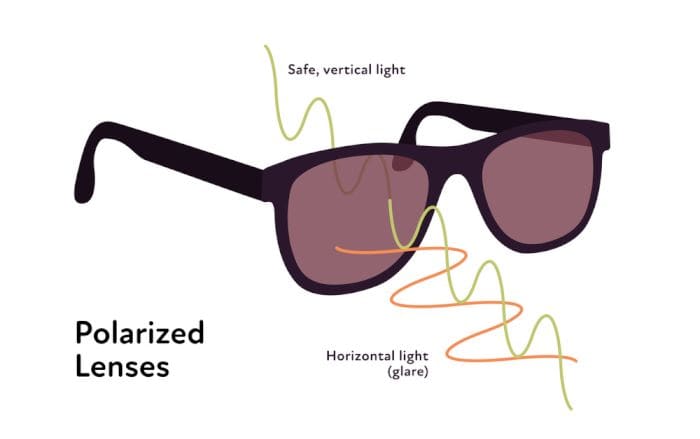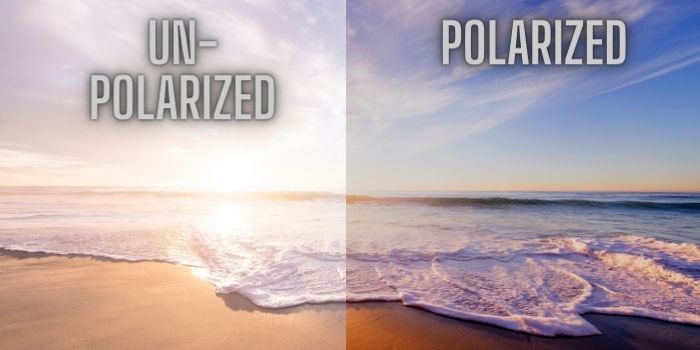When it comes to choosing sunglasses, most of us focus on fit, style, and how cool it looks on you. But what about whether you should get polarized or non-polarized sunglasses?
Is one better than the other? Whether you’re planning to lounge by the pool, drive cross-country or hit the slopes, understanding the difference between these two lens types is something you’ll want to pay attention to.
What are Polarized Lenses?

Polarized lenses are specially designed lenses that help reduce glare caused by light reflecting off the surface of water, snow, and other shiny surfaces. They are especially helpful for activities like boating and fishing, where you need to be able to see well in bright sunlight.
They’re perfect for people who spend time near water or in bright outdoor conditions.
How Polarized Sunglasses Work
Polarized sunglasses have a special filter applied that blocks intense reflected light. The secret is in the lens coating, which allows only vertical light to pass through.
Horizontal light, which is responsible for glare, gets filtered out, leaving you with clearer, more comfortable vision.
Benefits of Polarized Lenses

The biggest benefit to polarized lenses is that they reduce glare significantly. This makes them excellent for outdoor activities like fishing, cycling, and even driving.
You’ll find that your eyes are less strained and less fatigued after wearing polarized lenses since you won’t need to squint. You can clearly see the horizon line while out on the water or snow, making your visual experience much more comfortable.
Additionally, better contrast and color perception come naturally with polarized lenses. With horizontal light blocked out, more vertically polarized light can pass through, improving contrast and making colors appear more vibrant.
Drawbacks of Polarized Sunglasses

Despite the great benefits, some circumstances aren’t always ideal for polarized lenses. For example, if you’re a skier, reduced glare off the snow is helpful, but they can also reduce your ability to spot icy patches.
Viewing LED or digital screens such as your smartphone may be tricky too. Polarized lenses can make digital screens appear very dark or distorted.
That’s because digital screens are built with a polarizing filter themselves, so when you try to view them through polarized sunglasses, the two filters cancel each other out.
(If you aren’t sure whether your sunglasses are polarized or not, an easy way to test for this is to wear your sunglasses and look at your smartphone. Then turn the device 90 degrees – if all you see is black when that happens, you have polarized lenses.)
Note that polarized lenses do not inherently protect your eyes from UV rays, so for best results, be sure to get a pair that’s also 100% UV-blocking.
What are Non-Polarized Lenses?
Non-polarized lenses provide UV-protection and shading without glare-blocking filters.
How Non-Polarized Sunglasses Work
Non-polarized sunglasses block UVA/UVB rays and reduce the amount of light entering your eyes. They offer uniform shading but don’t reduce the glare you’ll see off reflective surfaces.
Benefits of Non-Polarized Sunglasses

One advantage of non-polarized sunglasses is their affordability. They are generally less expensive compared to polarized sunglasses.
Another benefit is their versatility for everyday wear. They can be used for various activities without any specific limitations typically associated with polarized lenses.
Lastly, the absence of screen visibility issues allows you to easily check your smartphone or read a digital sign without taking your sunglasses off.
Drawbacks of Non-Polarized Sunglasses
The biggest disadvantage of non-polarized sunglasses is that they don’t provide any protection against glare. This means you’re more likely to be blinded by the sun’s reflection off a body of water or snow while out on the slopes.
As a result, you may have increased eye strain and fatigue if you spend a lot of time outdoors in bright conditions.
Comparing Polarized and Non-Polarized Sunglasses
Performance

Polarized sunglasses make a big difference when it’s blindingly sunny out, making them a popular choice for outdoor enthusiasts. Their enhanced visual clarity and comfort in bright situations offer several advantages in specific scenarios:
- Driving: Polarized lenses minimize glare from sunlight reflecting off other vehicles, wet roads, or snow. This results in improved vision and reduces eye strain during long drives.
- Water sports and fishing: Polarized sunglasses cut glare from the water’s surface, allowing you to see beneath the surface more clearly. This is particularly useful for anglers aiming to spot fish, or for water sports enthusiasts who need better visibility.
- Cycling and outdoor activities: Polarized lenses improve contrast and color perception, allowing you to better navigate your surroundings. This helps enhance safety and enjoyment during hikes, cycling, or other outdoor pursuits.
Non-polarized sunglasses provide basic shading, UV-protection and reduced light transmission without specialized glare-blocking features. In certain scenarios, they can be more suitable:
- Indoor sports and low-light conditions: In situations where glare is not a significant issue, non-polarized sunglasses may be sufficient. For example, indoor sports or overcast days where sunlight is less intense.
- Skiing and snowboarding: Non-polarized lenses might be more appropriate in these cases, as glare can help indicate icy patches on the slopes. In this particular scenario, polarized lenses may make it harder to detect these potentially dangerous areas.
- Reading digital devices: As discussed already, polarized lenses generally make viewing any digital screen – your smartphone, tablet, or LED signage – more difficult if not impossible. If you need to view digital screens throughout your day, you’re better off without polarized sunglasses.
Price

The price of sunglasses varies greatly based on factors such as brand, lens technology, frame materials, and design.
However, when comparing polarized and non-polarized sunglasses with similar features, polarized lenses are typically more expensive due to their specialized lens coating.
- Entry-level sunglasses: Non-polarized sunglasses with basic quality can be found for as little as $10 to $30, while polarized lenses in this category usually start at around $30 to $60.
- Mid-range sunglasses: Mid-range non-polarized sunglasses can cost between $60 and $150. Polarized sunglasses with improved lens and frame quality can range from $100 to $300.
- High-end sunglasses: Non-polarized sunglasses from designer brands or with advanced technical features can cost anywhere from $150 to $500 or more. High-quality polarized sunglasses with superior lens technology and stylish frames can easily range from $200 to $600 and even higher.
Tips for Choosing the Right Sunglasses
Determine Your Needs
Think about your lifestyle and activities. Are you involved in outdoor sports or spend a lot of time near or on the water? Polarized lenses are a good choice.
For casual, everyday use or indoor sports, non-polarized lenses may be sufficient.
Test Both Types of Lenses
Try on both polarized and non-polarized sunglasses. Pay attention to visual clarity, glare reduction, and overall comfort.
This will help you understand the differences between the two so you can decide which works best for you.
Consider Frame Style and Fit
Apart from lenses, the frame style and fit are important. Choose a frame that complements your face shape and ensures a secure, comfortable fit for the activities you plan to use your sunglasses for.
Choose a Trusted Brand
Invest in a reputable brand that offers quality sunglasses. Reliable brands generally use high-quality materials and provide better protection for your eyes.
Cheap shades you’ll find from your local gas station or drug store might be affordable, but they may not provide adequate protection.